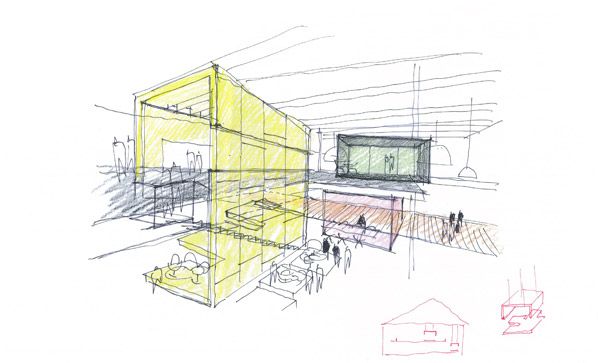Woods Bagot’s Head of Interiors, Todd Hammond, and Principal, Domenic Alvaro, talk concept development for the new Living Edge showroom at The Woolstores Alexandria

Concept sketch for the new Living Edge showroom by Dominic Alvaro, Woods Bagot Sydney
January 29th, 2015
When and how did the partnership with Living Edge eventuate?
DOM: Woods Bagot is lucky enough to have good relationships with a number of the best furniture suppliers in Australia and overseas, including Living Edge. So our history really gave us the background we needed to work with Living Edge on this exciting project.
What was the initial brief and how have you – in collaboration with Living Edge – evolved and developed the concept?
DOM: The Woolstores Alexandria is transforming into a retail hub, with two tenants per warehouse – Living Edge will share with Swarovski and other design brands are being finalized for the other warehouse spaces.
Interestingly, the sheds themselves were built in WWII as wool stores for wool to be transported from around Australia before being shipped out. After it fell into disuse they were used as a storage sheds. As a result of it’s heritage, the structure is predominantly timber, which has aged beautifully.
The brief was to create a shop front/window display within the heritage building, with a particular emphasis on showcasing the Living Edge brand as well as the brands they supply, the most prominent being Herman Miller.
TODD: We used the double height spaces on the perimeter of building to create a structure that acts as a framing device to display products over multiple floors, which Living Edge was certainly going to need for their expansive product offering.
There has been a real shift in the supplier market over the last 3-5 years with regard to how showrooms and retailers create high-impact and engaging environments for their clients. How have you interpreted this trend in the Living Edge project?
TODD: It’s all about immersion; creating volumes of space, stepping into a showroom from Herman Miller, E15 or any one of their many brands – and having an immersive experience with each of them; creating the opportunity for any visitor to properly connect with Living Edge products.
What were/are some of the key considerations when designing the concept?
TODD: The heritage nature of the building was a key consideration and we specifically engaged a heritage consultant who’s written a report, which gives us context, and could help us preserve and restore the beautiful structure. The translation between the heritage building and the new fit-out is the critical part of the concept – the connection points between the two.
How will the Living Edge showroom concept fit into the larger idea of Alexandria, and specifically the Woolstores, becoming Sydney’s best design precinct?
DOM: The Woolstores Alexandria are an extension of the food and retail precinct of the Grounds, which have been enormously successful. The Woolstores provides an interesting backdrop for a new retail precinct that focuses on design. There are lots of pedestrian thoroughfares – almost like a laneway environment with a pedestrian access – offering a well-defined balance of community and an outdoor retail complex. Living Egde will be offering a whole range of items from furniture through to homewares and even fashion-orientated items such as designer watches. They’ve also picked up Vitra homewares which will only add to the list of reasons to visit the space.
What were/are some of the challenges throughout this process, and how have they been solved?
TODD: The challenge here is that there is no street frontage for the showroom. We thought creatively and managed to get around this by creating high impact, double height displays that are visible to pedestrians as they explore the Woolsheds precinct.
How will the physical design of the showroom represent the Living Edge identity? What are some of the custom elements you have created to achieve this goal?
TODD: We’re using a combination of timbers – American Oak, stained in a few colours, using concrete to contrast with the base building timbers. The colours are aligned to the brand, using the yellow of Living Edge as well as some of the colours used by the brands they supply. Living Edge is a classic and understated brand, with a certain refined dignity – it was natural that the design aesthetically reflected that presence.
The Living Edge showroom at The Woolstores Alexandria is set to launch on Feb 10 2015.
WOODS BAGOT SYDNEY
woodsbagot.com
LIVING EDGE
livingedge.com.au
INDESIGN is on instagram
Follow @indesignlive
A searchable and comprehensive guide for specifying leading products and their suppliers
Keep up to date with the latest and greatest from our industry BFF's!

A longstanding partnership turns a historic city into a hub for emerging talent

Gaggenau’s understated appliance fuses a carefully calibrated aesthetic of deliberate subtraction with an intuitive dynamism of culinary fluidity, unveiling a delightfully unrestricted spectrum of high-performing creativity.

BLANCOCULINA-S II Sensor promotes water efficiency and reduces waste, representing a leap forward in faucet technology.

In this candid interview, the culinary mastermind behind Singapore’s Nouri and Appetite talks about food as an act of human connection that transcends borders and accolades, the crucial role of technology in preserving its unifying power, and finding a kindred spirit in Gaggenau’s reverence for tradition and relentless pursuit of innovation.

The Centenary Library at Anglican Church Grammar School (QLD) supports nuanced cognitive behaviour for staff and students alike.

The Wilson Architects-designed Learning Hub at St. Andrew’s Anglican College represents a new approaches to educational best practice in design.
The internet never sleeps! Here's the stuff you might have missed

Throughout his life, Ong Tze Boon has made a real difference to both people and place. He is a man of vision who has changed the architectural landscape of Singapore and South-East Asia and strives to make a better world for the future.

In an era where the demands of modern work often clash with the need for restoration, The Commons Health Club in Melbourne sets a new precedent.